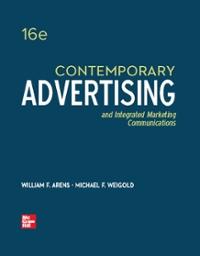Question
Consider Diane's optimal labor and leisure decision. She earns a wage of $10 an hour and is able to work 180 hours a month. In
Consider Diane's optimal labor and leisure decision. She earns a wage of $10 an hour and is able to work 180 hours a month. In order to work, she must pay $3 in childcare costs for every hour worked. Diane has a utility function over consumption spending and leisure equal to (, ) = 10 1/2 + Where is dollars of consumption and is hours of leisure.
Now suppose that Diane's income is subject to a flat tax of 10% and that child care expenses are not tax deductible.
A. Update Diane's budget constraint to reflect the 10% tax on income.
B. Determine Diane's optimal choice of leisure, consumption and labor under the tax.
C. How does Diane's supply of labor change in response to the tax? What does this imply about the relative strengths of the income and substitution effects for Diane?
D. How much tax does the government collect from Diane?
Step by Step Solution
There are 3 Steps involved in it
Step: 1

Get Instant Access to Expert-Tailored Solutions
See step-by-step solutions with expert insights and AI powered tools for academic success
Step: 2

Step: 3

Ace Your Homework with AI
Get the answers you need in no time with our AI-driven, step-by-step assistance
Get Started


